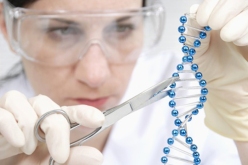By: Aditya Nair

A clever modification to a bacterial immune response could hold the key to curing hundreds of genetic diseases.
We humans, from our selfish point of view, are accustomed to considering bacteria as agents of infection and the causes of great suffering. The all too common “strep throat” is the result of infection by a family of bacteria known as streptococcus. Clostridium Botulinum produces the strongest known toxin in the world. Some of the more active members of society may be familiar with staph infection, the scourge of athletes and athletic trainers nationwide. It could even be argued that the very course of human history has been altered by bacteria; the bubonic plague (Yersinia pestis) is a bacterial disease.
However, bacteria do not enjoy a “free ride” biologically. They are not merely parasites limited by the number of hosts that they can infect. They, just like us, have natural predators. For example, a bacteriophage is a virus that infects bacteria. In order to replicate, a bacteriophage must insert its genetic material into the bacteria; then, the bacteriophage’s DNA can be incorporated into the bacteria’s own DNA. The bacteriophage genetic material causes the bacteria to change its cellular processes to begin producing more of the bacteriophage.
Humans have elaborate immune systems that deal with this sort of threat, and as it turns out, bacteria may be equipped with them too. CRISPRs (clustered regularly interspaced short palindromic repeats) are sections of DNA in bacteria that code for and work with proteins called Cas (CRISPR-associated) proteins that can inactivate foreign DNA such as that inserted by a bacteriophage. In the process, the CRISPR system incorporates a section of the foreign DNA into its own genetics, which helps it recognize and inactivate foreign DNA during future infections.
The fact that bacteria were able to selectively modify their own DNA was of great interest to scientists. The implications became clear very quickly. Could it be possible to re-engineer this system so that any given sequence of DNA could be inserted into bacterial genomes? Could this system work in eukaryotes or even mammals? Could this system be used to cure genetic diseases?
The answer to all of these questions is yes.
CRISPR immunity works by recognizing particular sequences of DNA, and using those sequences as guidance to know when to make cuts. The section of DNA that is cut out can be replaced with new DNA, or can merely be deleted, with the cut ends coming back together. By re-engineering the sequences that the CRISPR system recognizes, scientists can cut almost anywhere in the genome, and replace the excised section with another one.
This is an ability that scientists have had for many years. However, previous approaches often required the killing of cells, laboratory isolation of DNA, and a rather difficult and roundabout process to re-incorporate DNA into a limited range of possible living beings.
However, CRISPR can work while an animal is still living, and there’s incredible evidence that the biological systems allowing it to work in bacteria will also work in mammals.
Amazingly, in March, a team from MIT was successful in correcting a rare genetic liver disorder in mice using the system, altering the very genome of the mouse to cure the disease.
We may very well be witnessing the birth of a revolution in genetic medicine, equipped with the ability to delete faulty genes and substitute them with healthy versions. Genetic disorders could soon be relics of the past, and the age of genetic engineering may well be upon us.
And who would have thought that the keys to this technology lay within our sworn enemies, the lowly bacteria.
